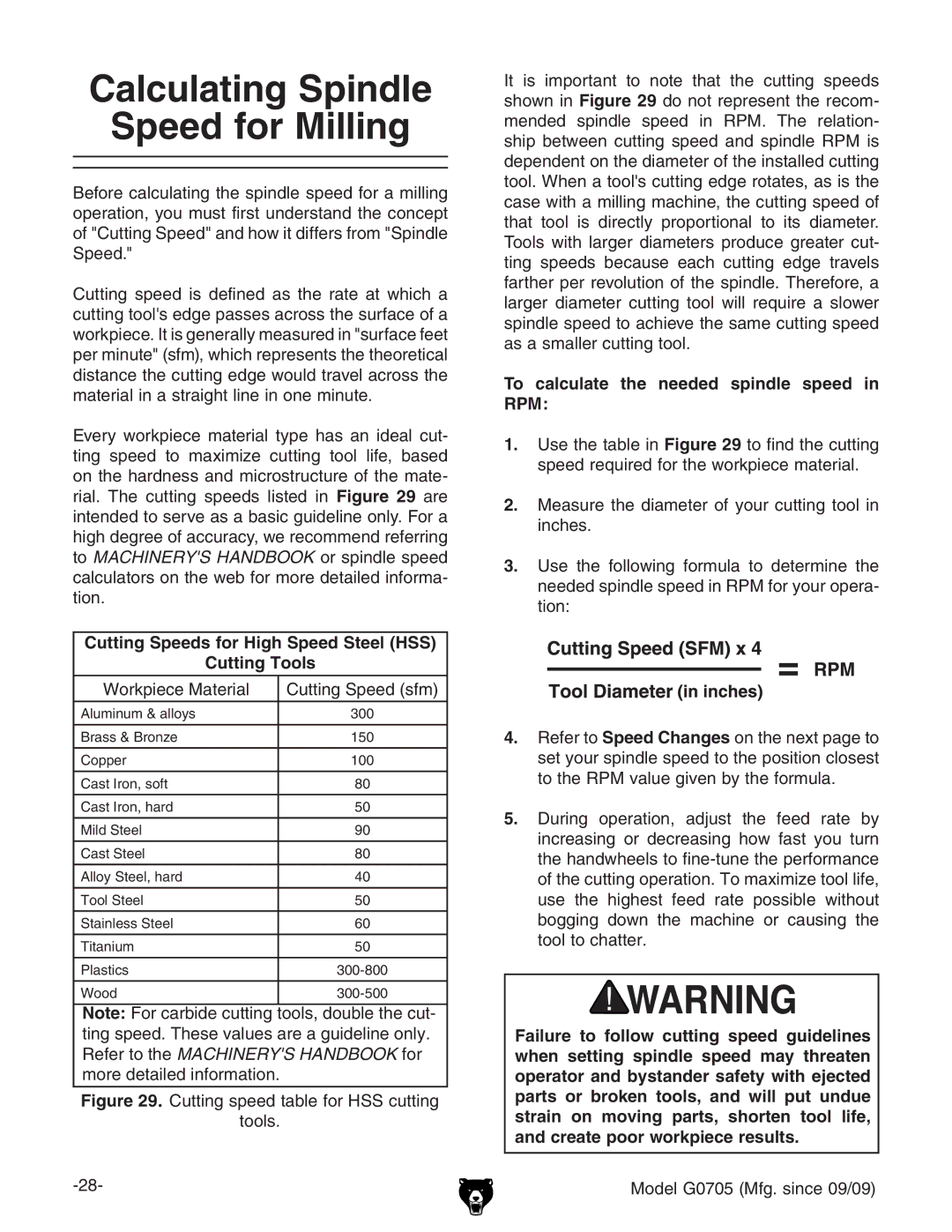
Calculating Spindle
Speed for Milling
Before calculating the spindle speed for a milling operation, you must first understand the concept of "Cutting Speed" and how it differs from "Spindle Speed."
Cutting speed is defined as the rate at which a cutting tool's edge passes across the surface of a workpiece. It is generally measured in "surface feet per minute" (sfm), which represents the theoretical distance the cutting edge would travel across the material in a straight line in one minute.
Every workpiece material type has an ideal cut- ting speed to maximize cutting tool life, based on the hardness and microstructure of the mate- rial. The cutting speeds listed in Figure 29 are intended to serve as a basic guideline only. For a high degree of accuracy, we recommend referring to MACHINERY'S HANDBOOK or spindle speed calculators on the web for more detailed informa- tion.
Cutting Speeds for High Speed Steel (HSS)
Cutting Tools
Workpiece Material | Cutting Speed (sfm) |
|
|
Aluminum & alloys | 300 |
|
|
Brass & Bronze | 150 |
|
|
Copper | 100 |
|
|
Cast Iron, soft | 80 |
|
|
Cast Iron, hard | 50 |
|
|
Mild Steel | 90 |
|
|
Cast Steel | 80 |
|
|
Alloy Steel, hard | 40 |
|
|
Tool Steel | 50 |
|
|
Stainless Steel | 60 |
|
|
Titanium | 50 |
|
|
Plastics | |
|
|
Wood |
Note: For carbide cutting tools, double the cut- ting speed. These values are a guideline only. Refer to the MACHINERY'S HANDBOOK for more detailed information.
Figure 29. Cutting speed table for HSS cutting
tools.
It is important to note that the cutting speeds shown in Figure 29 do not represent the recom- mended spindle speed in RPM. The relation- ship between cutting speed and spindle RPM is dependent on the diameter of the installed cutting tool. When a tool's cutting edge rotates, as is the case with a milling machine, the cutting speed of that tool is directly proportional to its diameter. Tools with larger diameters produce greater cut- ting speeds because each cutting edge travels farther per revolution of the spindle. Therefore, a larger diameter cutting tool will require a slower spindle speed to achieve the same cutting speed as a smaller cutting tool.
To calculate the needed spindle speed in RPM:
1.Use the table in Figure 29 to find the cutting speed required for the workpiece material.
2.Measure the diameter of your cutting tool in inches.
3.Use the following formula to determine the needed spindle speed in RPM for your opera- tion:
4.Refer to Speed Changes on the next page to set your spindle speed to the position closest to the RPM value given by the formula.
5.During operation, adjust the feed rate by increasing or decreasing how fast you turn the handwheels to
Failure to follow cutting speed guidelines when setting spindle speed may threaten operator and bystander safety with ejected parts or broken tools, and will put undue strain on moving parts, shorten tool life, and create poor workpiece results.
Model G0705 (Mfg. since 09/09)
